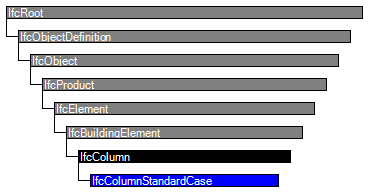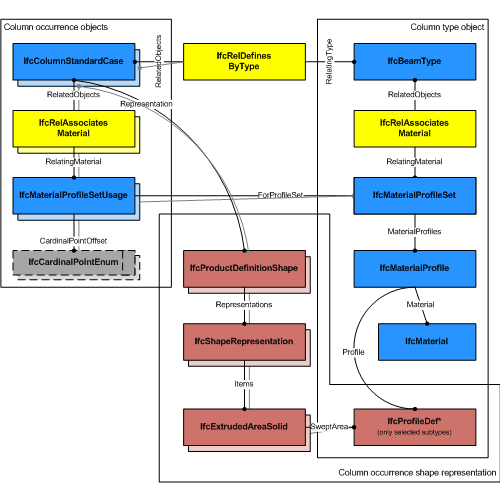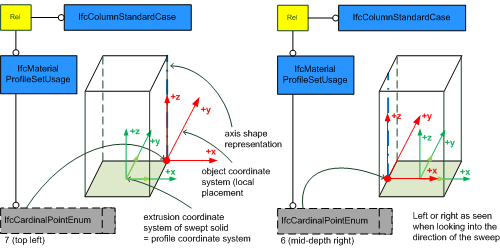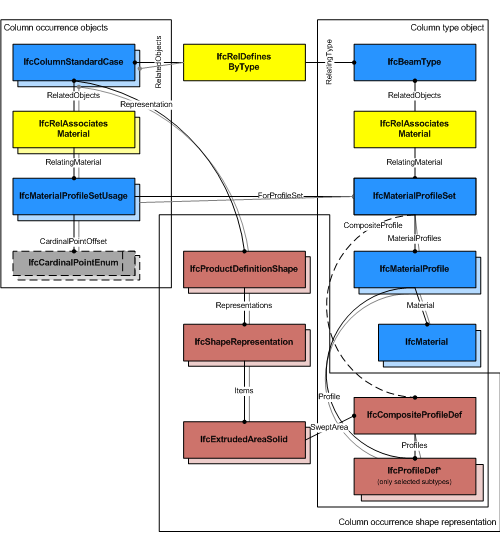Natural language names
 | Stütze / Pfeiler - Standard |
 | Column Standard Case |
 | Poteau standard |
 | Stütze / Pfeiler - Standard |
 | Column Standard Case |
 | Poteau standard |
| Item | SPF | XML | Change | Description | IFC2x3 to IFC4 |
|---|---|---|---|---|
| IfcColumnStandardCase | ADDED | IFC4x1 to IFC4x2 | ||
| IfcColumnStandardCase | ||||
| PositionedFrom | ADDED |
The standard column, IfcColumnStandardCase, defines a column with certain constraints for the provision of material usage, parameters and with certain constraints for the geometric representation. The IfcColumnStandardCase handles all cases of columns, that:
NOTE View definitions and implementer agreements may further constrain the applicable geometry types, e.g. by excluding tapering from an IfcBeamStandardCase implementation.
HISTORY New entity in IFC4.
Geometric Representations
The geometric representation of IfcColumnStandardCase is defined using the following multiple shape representations for its definition:
NOTE It is invalid to exchange a 'SurfaceModel', 'Brep', or 'MappedRepresentation' representation for the 'Body' shape representation of an IfcColumnStandardCase.
| Rule | Description |
|---|---|
| HasMaterialProfileSetUsage | A valid instance of IfcColumnStandardCase relies on the provision of an IfcMaterialProfileSetUsage. |

| # | Attribute | Type | Cardinality | Description | B |
|---|---|---|---|---|---|
| IfcRoot | |||||
| 1 | GlobalId | IfcGloballyUniqueId | [1:1] | Assignment of a globally unique identifier within the entire software world. | X |
| 2 | OwnerHistory | IfcOwnerHistory | [0:1] |
Assignment of the information about the current ownership of that object, including owning actor, application, local identification and information captured about the recent changes of the object,
NOTE only the last modification in stored - either as addition, deletion or modification. | X |
| 3 | Name | IfcLabel | [0:1] | Optional name for use by the participating software systems or users. For some subtypes of IfcRoot the insertion of the Name attribute may be required. This would be enforced by a where rule. | X |
| 4 | Description | IfcText | [0:1] | Optional description, provided for exchanging informative comments. | X |
| IfcObjectDefinition | |||||
| HasAssignments | IfcRelAssigns @RelatedObjects | S[0:?] | Reference to the relationship objects, that assign (by an association relationship) other subtypes of IfcObject to this object instance. Examples are the association to products, processes, controls, resources or groups. | X | |
| Nests | IfcRelNests @RelatedObjects | S[0:1] | References to the decomposition relationship being a nesting. It determines that this object definition is a part within an ordered whole/part decomposition relationship. An object occurrence or type can only be part of a single decomposition (to allow hierarchical strutures only). | ||
| IsNestedBy | IfcRelNests @RelatingObject | S[0:?] | References to the decomposition relationship being a nesting. It determines that this object definition is the whole within an ordered whole/part decomposition relationship. An object or object type can be nested by several other objects (occurrences or types). | X | |
| HasContext | IfcRelDeclares @RelatedDefinitions | S[0:1] | References to the context providing context information such as project unit or representation context. It should only be asserted for the uppermost non-spatial object. | ||
| IsDecomposedBy | IfcRelAggregates @RelatingObject | S[0:?] | References to the decomposition relationship being an aggregation. It determines that this object definition is whole within an unordered whole/part decomposition relationship. An object definitions can be aggregated by several other objects (occurrences or parts). | X | |
| Decomposes | IfcRelAggregates @RelatedObjects | S[0:1] | References to the decomposition relationship being an aggregation. It determines that this object definition is a part within an unordered whole/part decomposition relationship. An object definitions can only be part of a single decomposition (to allow hierarchical strutures only). | X | |
| HasAssociations | IfcRelAssociates @RelatedObjects | S[0:?] | Reference to the relationship objects, that associates external references or other resource definitions to the object.. Examples are the association to library, documentation or classification. | X | |
| IfcObject | |||||
| 5 | ObjectType | - | This attribute is out of scope for this model view definition and shall not be set. | ||
| IsTypedBy | IfcRelDefinesByType @RelatedObjects | S[0:1] | Set of relationships to the object type that provides the type definitions for this object occurrence. The then associated IfcTypeObject, or its subtypes, contains the specific information (or type, or style), that is common to all instances of IfcObject, or its subtypes, referring to the same type. | X | |
| IsDefinedBy | IfcRelDefinesByProperties @RelatedObjects | S[0:?] | Set of relationships to property set definitions attached to this object. Those statically or dynamically defined properties contain alphanumeric information content that further defines the object. | X | |
| IfcProduct | |||||
| 6 | ObjectPlacement | IfcObjectPlacement | [0:1] | Placement of the product in space, the placement can either be absolute (relative to the world coordinate system), relative (relative to the object placement of another product), or constraint (e.g. relative to grid axes). It is determined by the various subtypes of IfcObjectPlacement, which includes the axis placement information to determine the transformation for the object coordinate system. | X |
| 7 | Representation | IfcProductRepresentation | [0:1] | Reference to the representations of the product, being either a representation (IfcProductRepresentation) or as a special case a shape representations (IfcProductDefinitionShape). The product definition shape provides for multiple geometric representations of the shape property of the object within the same object coordinate system, defined by the object placement. | X |
| ReferencedBy | IfcRelAssignsToProduct @RelatingProduct | S[0:?] | Reference to the IfcRelAssignsToProduct relationship, by which other products, processes, controls, resources or actors (as subtypes of IfcObjectDefinition) can be related to this product. | X | |
| IfcElement | |||||
| 8 | Tag | IfcIdentifier | [0:1] | The tag (or label) identifier at the particular instance of a product, e.g. the serial number, or the position number. It is the identifier at the occurrence level. | X |
| ConnectedTo | IfcRelConnectsElements @RelatingElement | S[0:?] | Reference to the element connection relationship. The relationship then refers to the other element to which this element is connected to. | ||
| HasOpenings | IfcRelVoidsElement @RelatingBuildingElement | S[0:?] | Reference to the IfcRelVoidsElement relationship that creates an opening in an element. An element can incorporate zero-to-many openings. For each opening, that voids the element, a new relationship IfcRelVoidsElement is generated. | X | |
| ConnectedFrom | IfcRelConnectsElements @RelatedElement | S[0:?] | Reference to the element connection relationship. The relationship then refers to the other element that is connected to this element. | X | |
| ContainedInStructure | IfcRelContainedInSpatialStructure @RelatedElements | S[0:1] | Containment relationship to the spatial structure element, to which the element is primarily associated. This containment relationship has to be hierachical, i.e. an element may only be assigned directly to zero or one spatial structure. | ||
| PositionedFrom | IfcRelPositions @RelatingElement | S[0:1] | Indicates a constrained placement, where the ObjectPosition must match positioning defined according to the referenced positioning element. | X | |
| IfcBuildingElement | |||||
| IfcColumn | |||||
| 9 | PredefinedType | IfcColumnTypeEnum | [0:1] |
Predefined generic type for a column that is specified in an enumeration. There may be a property set given specificly for the predefined types.
NOTE The PredefinedType shall only be used, if no IfcColumnType is assigned, providing its own IfcColumnType.PredefinedType. | X |
| IfcColumnStandardCase | |||||
Columns are used to represent linear members with primary function of vertical axial loading such as the vertical portion of a pier. The general definition IfcColumn defines a fixed shape, while the subtype IfcColumnStandardCase allows for parametric resizing.
Material Profile Set Usage
The Material Profile Set Usage concept applies to this entity.
The IfcColumnStandardCase defines in addition that the IfcColumnType should have a unique IfcMaterialProfileSet, that is referenced by the IfcMaterialProfileSetUsage assigned to all occurrences of this IfcColumnType. Composite profile columns can be represented by refering to several IfcMaterialProfile's within the IfcMaterialProfileSet that is referenced from the IfcMaterialProfileSetUsage.
Figure 177 illustrates assignment of IfcMaterialProfileSetUsage and IfcMaterialProfileSet to the IfcColumnStandardCase as the column occurrence and to the IfcColumnType. The same IfcMaterialProfileSet shall be shared by many occurrences of IfcMaterialProfileSetUsage. This relationship shall be consistent to the relationship between the IfcColumnType and the IfcColumnStandardCase.
 |
Figure 177 — Column profile usage |
Figure 178 illustrates cardinal point alignment.
NOTE It has to be guaranteed that the use of IfcCardinalPointEnum is consistent to the placement of the extrusion body provided by IfcExtrudedAreaSolid.Position
NOTE The cardinal points 7 (top left), and 6 (mid-depth right) are assigned according to the definition at IfcCardinalPointReference
 |
Figure 178 — Column cardinal points |
Figure 179 illustrates assignment of a composite profile by using IfcCompositeProfile for geometric representation and several IfcMaterialProfile's within the IfcMaterialProfileSet. The number of IfcMaterialProfile's within the IfcMaterialProfileSet is restricted to maximal 2 and requires the use of IfcExtrudedAreaSolidTapered, or IfcRevolvedAreaSolidTapered for the correct 'Body' shape representation.
 |
Figure 179 — Column composite profiles |
| # | Concept | Model View |
|---|---|---|
| IfcRoot | ||
| Software Identity | Bridge View | |
| User Identity | Bridge View | |
| Object Ownership | Bridge View | |
| IfcObject | ||
| Property Sets for Objects | Bridge View | |
| IfcElement | ||
| Element Occurrence Attributes | Bridge View | |
| Product Local Placement | Bridge View | |
| Product Assignment | Bridge View | |
| IfcColumn | ||
| Object Typing | Bridge View | |
| Quantity Sets | Bridge View | |
| Element Decomposition | Bridge View | |
| Body SweptSolid Geometry | Bridge View | |
| Annotation 2D Geometry | Bridge View | |
| Surface Connectivity | Bridge View | |
| IfcColumnStandardCase | ||
| Material Profile Set Usage | Bridge View | |
<xs:element name="IfcColumnStandardCase" type="ifc:IfcColumnStandardCase" substitutionGroup="ifc:IfcColumn" nillable="true"/>
<xs:complexType name="IfcColumnStandardCase">
<xs:complexContent>
<xs:extension base="ifc:IfcColumn"/>
</xs:complexContent>
</xs:complexType>
ENTITY IfcColumnStandardCase
SUBTYPE OF (IfcColumn);
WHERE
HasMaterialProfileSetUsage : SIZEOF (QUERY(temp <* USEDIN(SELF, 'IFCKERNEL.IFCRELASSOCIATES.RELATEDOBJECTS') |
('IFCPRODUCTEXTENSION.IFCRELASSOCIATESMATERIAL' IN TYPEOF(temp)) AND
('IFCMATERIALRESOURCE.IFCMATERIALPROFILESETUSAGE' IN TYPEOF(temp.RelatingMaterial))
)) = 1;
END_ENTITY;